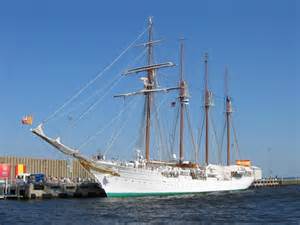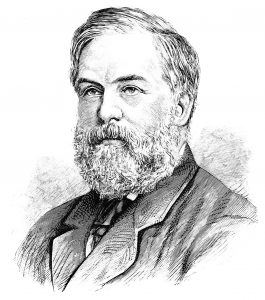In our last two lessons we followed the development of modern science.
It begins with observations (ocean currents, orbit of the moon) – which led to logical explanations (whatever you all came up with right/wrong) – and then the need to be tested (dropping a rock or counting M&Ms). Repeated testing gives us better information (data) to draw conclusions from.
In Lesson 4 we are going to look one last piece to the process as well as bring the efforts of the ancient sailors together with the efforts of the early scientists. The piece that is missing… technology.
Our lessons on the development covered the periods of the 1500, 1600, and 1700s. During this same time period human exploration of the sea had continued as well. Better ships were built, navigation improved, new markets had been developed, and new maps of the world had been drawn. They could not explain the pattern of the ocean currents, but they knew where they were and had named them. With the expansion of these new commercial markets came a need for new and stronger navies to protect them.

Photo: University of West Florida
The 1600s in particular was a heavy time of piracy. Most of these markets were exploited by European nations – Spain, France, Holland, Portugal, and England in particular. There was certainly the need for a method of navigation across the oceans. They now understood the planet was a sphere and that you determined your position on the sphere by using the position of the stars and sun. But the captains needed a tool, or instrument to determine this angle accurately before they could cross major oceans. There were such devices developed as far back as the Greek period, these were tracking the stars for astronomy. It was discovered that the Polaris, the north star, did not rotate – but rather all the other stars rotated around it. This was a good choice to take a sight from since it was fixed in the sky. Polaris is at a 90° angle at the north pole and 0° at the equator. Getting a sight of the angle at night would tell you where you were between the equator and the north pole – latitude. It would not be until the early 1700s before the classic sextant was developed to measure this angle, and the angle of the sun at noon to determine the same thing. This tool, TECHNOLOGY, was developed by two different people – one British and one American, at about the same time.
But how far were you between Europe and America? East and west?
That would also be developed by an Englishman who understood that the earth rotated. By knowing your local time, and the exact time in London, you could determine your degree longitude, by comparing the time difference (an early version of what we call time zones). To determine this, captains needed a clock that gave accurate time in London while they waited for the sun to be at its highest point of the day at sea – its zenith, which was 12:00 noon their time. Using these two, they could determine their longitude for a table developed for this. The time piece with London time became known as the chronometer and 0° was Greenwich England where its inventor, John Harrison, lived. This where the term Greenwich Mean Time or Zulu in the military came from. With the chronometer, sextant, compass, and charts sea captains now had the tools-technology to sail the words oceans.

This is an important step in the Nature of Science. If you visit college campuses you see not the The College of Science… but The College of Science and Technology, or The College of Engineering and Science. For science cannot advance without technology.
Examples:
– In the early days of chemistry, they only had a candle to use as a source of heat. This can only get so hot. So, no discoveries could be made until someone could develop a good source of heat that could be changed for experiments. When the Bunsen burner was developed – chemistry took off.
– The invention of the microscope advanced the study of biology.
– The telescope the science of astronomy
– Particle accelerators, vacuums, and photography would all be important technologies needed for the advancement of science
They say Pensacola has the worlds whitest beaches. Is this true? We can certainly look at samples of beach sand from around the world and – by OBSERVATION – determine which is whiter, but is this science? We need a machine that can measure the whiteness of an object, we need technology to accurate TEST this statement. Who will develop such a thing? Who will ENGINEER this technology?
This brings us back to our story of the advancement of science and the advancement of the commercial shipping. By the late 1700s England was the master of the sea and had colonies/markets all over the world. It was said that “the sun never sets on the Union Jack” – which is the nickname for the British flag. And it was true. Wherever the sun was up, there was a British colony nearby. But it took a mighty navy to protect these commercial interests and, in the 1700 and 1800s, England had the best.
It was in the mid-1800s that the advancement of science and sailing would meet. And it would be partly due to the fact that the British Navy needed to protect British colonies and commercial interests.

Photo: NOAA
Sailors had been plowing the open ocean for almost 300 years by this time. There had been lots of OBSERVATIONS, some of these led to discoveries. But there were many other questions left unanswered. How deep was the ocean? What was the bottom like? There were of course the legends of the Kraken and mermaids that needed “TESTING”. There were lots of questions about the natural resources of the new lands the British had colonies in. Were any of these of value to them? It was not long before a scientist would travel on voyages to answer such questions – Charles Darwin was one.
In the mid-1800s college professors were telling students that the ocean floor was probably flat, sandy or muddy, and lifeless. This was challenged by some students, one in particular – Charles Wyville Thomson. The student’s argument was that these explanations were logical – but just that – logical, there was no evidence, they had not been tested. It was almost like we had gone back in time with science. Thomson and others would push this issue that these ideas needed to be tested – that a voyage of marine science was needed to test them. But this would be expensive, how bad do we need to know these answers? Can we justify the expense? Is this a good use of taxpayers’ dollars (or pounds)? Sounds like our missions to the moon and the one proposed for Mars doesn’t it. And it was.

Image” London Museum
They banked on the idea that if you wanted the strongest navy in the world to protect your commercial interests around the globe, you needed to know as much as possible about the oceans as you could learn. Currents and tides – what caused them? Ocean depth and sediments – were there any resources there? Was the bottom of the sea lifeless – was there any value there? Those who understood the sea – ruled it.
The scientists may have conducted these studies out of curiosity, but the investors were looking for a return on investment and were hoping for new commercial products with these voyages. Thus, was born the first voyage of marine science – The Voyage of the HMS Challenger. In 1872 Thomson built a team of scientists – biologists, chemists, geologists, to sail around the world over a five-year period to collect samples and information from all parts of the ocean. They would make many discoveries including deep ocean mountain ranges, the deepest part of the ocean – the Challenger Deep – plankton, deep sea life from the deepest parts of the ocean – life did exist there, how salinity and temperature changes with depth, how currents changed with depth, and enough information and drawing to fill several volumes of books. But from the get-go, there was a problem….
1) How do you measure the depth of the ocean?
2) How do you collect a water sample from 1000 feet but not mix it with surface water bringing it to the surface?
3) How do you collect creatures from the deep sea?
There was a technology problem, which they would eventually solve, but like all other science – they could not move forward until we solved it.
ACTIVITY
#1 – We are going to let you try this. Let’s put you in the room with Thomson and the rest of the team. You have the three technology questions listed above. Can you come up with some way to sample and solve those problems? DO NOT WORRY ABOUT BEING RIGHT. It is easy to google this and see how they did it. BUT the idea of designing it yourself is more fun, interesting, and educational.
Sure… it may not work, but do you have any idea how many different machines have been designed that did not work? Look at the early models of the airplane! We learn from each of these and eventually come up with something that does.
In the real world you would of course want to test these technologies. Think about our space program in the 1960s. They did not just come up with an idea of launching a rocket with people on it and landing on the moon. They had to test every piece of technology involved with that to make sure it was safe and have a high probability of working. LOTS of testing. But for this activity we are just going to design.
Should be fun and educational.
#2 – There is a movie entitled Master and Commander starring Russell Crowe. This film depicts the life of a sea captain and his relationship with the scientist who had been assigned to his ship. It might be worth a watch to get some idea of how science and sailing began their long affair into what we now call marine science.
#3 – This one might be a little tougher… can you design a machine that tests the “whiteness” of sand. I know I could not 😊 but if you have an engineering mind, you might come up with something that could. Again, just the idea-design.
FOR THE LITTLE KIDS
What kind of technology would you need to catch a fast lizard in your yard?
Can you develop a tool/technology to move a big rock?
What kind of tool/technology would you need to see what is living down a hole in your yard, or in a hollow in a tree?
AGAIN – YOU DO NOT HAVE TO DO THESE THINGS, JUST HAVE FUN DESIGNING SOMETHING THAT MIGHT
There are always Legos 😊
 0
0
